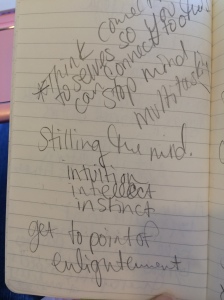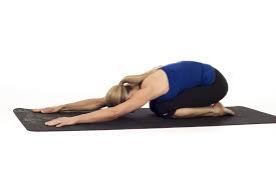I love Starbucks more than ever!*
TRANSCRIPTIONS
The two women were coming from yoga class at yogi power yoga (there email is yogipoweryoga@gmail in case I had additional questions).
Their names were Shannon and Piera. Shannon is a former accountant and Piera is a former lawyer. They both said yoga changed their lives. Both women gave up their jobs once they really found yoga. Opening a studio was Piera’s dream and her husband encouraged her to follow her dream. Yogi Power Yoga is Piera’s studio!
I asked the the women if they had any tips for me as I am just starting my yoga practice. They said that yoga is really all about knowing your body. You need to know when you can challenge and push your body and listen to when it needs rest. Rest a lot as you’re first starting out. It’s ok to rest and it’s ok to modify anything necessary. Also they said the more that you practice yoga—as in how often—the more you notice changes in your body.
I mentioned to them that I need to modify a lot of things. I said I don’t look like everyone else and that I don’t have the “perfect yoga body.” said yoga is about you; don’t worry what everyone else looks like. Everyone does poses differently because their bodies are different. There is no perfect yoga body. Anyone can do it. Piera even said “I do some yoga poses better than really skinny girls.” Some days you can do a lot with your body and others you can’t. You have to make sure you know your breath and feel how your body feels/reacts. They mentioned what you eat affects your yoga practice.
They mentioned that you can tell how certain foods affect your body. Piera began to tell a story to Shannon and I about her first ever yoga class. She said she farted during class. She said she was in law school at the time and never wanted to go back. Finally, however, she did go back She and Shannon both said farting is completely normal in yoga classes.
Next I asked them about the classes offered at their studio. There is not specific “hot yoga” that is more of a slang term. However, they practice Baptise style that keeps the studio around 80 dregrees. They welcome all levels of yogis and teach vinyasa classes and power yoga classes (more about strength). I mentioned I have done vinyasa before but not power. I asked if they were very different. They said there are mostly similar poses then a few different poses. They said there are different yoga discourses for different types of yoga, but some things are constant throughout all yoga.
SCENE
I was sitting in Starbucks writing my midterm for my graduate class with my friend Christina. We were helping and encouraging each other. About halfway through the midterm, two women sat down at the table adjacent to us. I heard them say things like “down dog” and “handstand” among others. Christina and I made eye contact and I mouth to her, “Oh my God! I think they are talking about yoga!” We eavesdropped on their conversation a little bit more, and Christina encouraged me to go over and talk to them. Being the outgoing type of person I am, I thought, “Why not?!”
I walked over to the table (a mere two steps) and said, “Excuse me, I couldn’t help but overhear your conversation a little bit. Are you two talking about yoga?”
The two women were in comfortable clothing. One was brunette and the other blonde. The brunette had on yoga pants, a black tank top, and a grey zip up hoodie. The blonde had on a white t-shirt and black yoga pants. They both had their hair in a messy bun and looked like they just finished a sweaty workout. They both held their coffee cups, looked at each other and smiled. “Yes,” one of them replied. “Are you a yogi?”
I said, “This is awesome. Hi, I’m Emily. I’m actually starting to study and research yoga; do you mind if I talk to you guys a little bit?”
They said sure. So, I pulled up a chair at the end of their table and began asking them questions.
They sat across from each other, so I sat at the end of the table. I asked them their names. Their names were Shannon and Piera. Shannon is a former accountant and Piera is a former lawyer. They both said yoga changed their lives. Both women gave up their jobs once they really found yoga. Piera said she really connected with yoga and was hating all the stress of being a lawyer. Opening a studio was Piera’s dream and her husband encouraged her to follow her dream. Yogi Power Yoga is Piera’s studio!
“That’s fantastic!” I replied. “Do you have any tips for a newbie?”
They said that yoga is really all about knowing your body. You need to know when you can challenge and push your body and listen to when it needs rest. Rest a lot as you’re first starting out. It’s ok to rest and it’s ok to modify anything necessary. Also they said the more that you practice yoga—as in how often—the more you notice changes in your body.
I mentioned to them that I need to modify a lot of things. I said I don’t look like everyone else and that I don’t have the “perfect yoga body.” They rolled their eyes and looked at each other briefly. They said yoga is about you; don’t worry what everyone else looks like. Everyone does poses differently because their bodies are different. There is no perfect yoga body. Anyone can do it. Piera even said “I do some yoga poses better than really skinny girls.” This made us all laugh.
Shannon said that some days you can do a lot with your body and others you can’t. You have to make sure you know your breath and feel how your body feels/reacts. They even mentioned what you eat affects your yoga practice.
They said that you can tell how certain foods affect your body.
I mentioned that I totally understood because after Mexican one night, I shouldn’t have done yoga. They both laughed and said they understood me.
Piera looked at Shannon and said “I don’t think I ever told you this before” and began to tell a story to Shannon and I about her first ever yoga class.
She said she was in law school at the time and needed some relaxing. Her and a friend decided to try it out. Piera said that it was a terrible experience because she farted during the beginning of class. She was so embarrassed. She wanted to leave but knew she had to finish the class. She said she never wanted to go back.
However, she did finally go back—years later—and was always glad she did. She and Shannon both said farting is completely normal in yoga classes because of the twists and bends you’re doing to your body.
We all had a laugh over the story and I asked them a little about their studio—specifically location and what classes were offered. She said it was right down the street.
They mentioned there is not specific “hot yoga” class; that is more of a slang term. However, they practice Baptise style that keeps the studio around 80 dregrees (which to me sounds like hot yoga!). They welcome all levels of yogis and teach vinyasa classes and power yoga classes (more about strength). I mentioned I have done vinyasa before but not power. I asked if they were very different. They said there are mostly similar poses then a few different poses. They said there are different yoga discourses for different types of yoga, but some things are constant throughout all yoga.
We ended our conversation with them talking to me a little more about the studio. I said, “I am a little worried about the ‘warm’ studio.”
They said to just come try it out and gave me their website to look up class times. Piera said she would let me try the first class for free (which I did do. The following Saturday and loved it). I said thank you to them both and walked back over to my seat where Christina smiled at me.
Quickly, I got out my fieldnotes notebook and jotted down everything I possibly could. As they left Starbucks they said, “Bye, Emily! It was nice meeting you!” and “Hope to see you in the studio!”
REFLECTION
Writing Ethnographic Fieldnotes states, “There are no hard and fast rules about whether to make jottings and if so, when and how to do so. But with time spent in a setting and by benefitting from trial and error, a field researcher may evolve a distinctive set of practices to fit writing jottings to the contours and constraints of that setting” (35). Let me tell you, I 100% agree! After trial and error I figured out what fits for me: right after the experience, sit down and WRITE! I jotted down notes from my conversation at Starbucks. This time I actually mean jotted! When I was doing my Bookstore Jottings, I tried to write down every little detail in complete sentences and wrote write in front of people because I felt I needed to jot down everything that they were saying as not to miss anything. Here, at the Starbucks, I was more confident interviewing them and felt like we were friendly with each other immediately. After talking with them, I quickly opened my fieldnotes notebook and felt amazingly confident writing my notes. It is something I accomplished on my own, and I am proud. I definitely see an improvement from last time to this because I did not write all complete sentences or write while I was talking to them. To create my scenes, I made sure to refer to the “Description” section in Writing Ethnographic Fieldnotes—pages 57-74. This really helped me to differentiate between the transcriptions to the descriptive part.
Honestly, I know I should reflect here on what I need to improve on, but I think it went perfectly. This was the best thing I had done so far. After this scene, I even took fieldnotes when I went there on Saturday (see my post on Hot Vinyasa Yoga for more information on that). Taking notes after that yoga class made me feel even more of an ethnographer because I kept thinking in the back of my mind about class and not fully immersing myself into the class. “Ethnographers, for example, have become skilled at activities they are seeking to understand…or, in good faith, have joined churches or religious groups…on the grounds that by becoming members, they gain fuller insight and understanding into these groups and their activities” (Writing Ethnographic Fieldnotes 3). I did this. I took the yoga class! However, “even with extensive participation, the ethnographer never becomes a member in the same sense that those who are “naturally” in the setting are members” (Writing Ethnographic Fieldnotes 5). I took the class, but wasn’t yet a “yogi.” I was thinking “how can I relate this to my research!” This was something I struggled to overcome, but now I truly do enjoy yoga on my own as well as think about my assignments for school!
*I thought I actually wrote this post a long time ago, but when I looked for it on my blog, it was nowhere to be found! Sorry it’s so late! 🙂

























